|
|
|
|
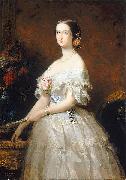 |
Edouard Louis Dubufe
|
|
Edouard Louis Dubufe (30 April 1820 - 11 August 1883) was a French painter.
He learned the art of painting from his father, Claude Marie Dubufe.
Until the 1840s, he painted primarily historical and biblical scenes, then switched to portrait painting. |
|
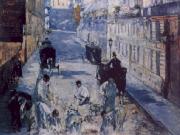 |
Edouard Manet
|
|
French Realist/Impressionist Painter, 1832-1883
The roughly painted style and photographic lighting in these works was seen as specifically modern, and as a challenge to the Renaissance works Manet copied or used as source material. His work is considered 'early modern', partially because of the black outlining of figures, which draws attention to the surface of the picture plane and the material quality of paint.
He became friends with the Impressionists Edgar Degas, Claude Monet, Pierre-Auguste Renoir, Alfred Sisley, Paul Cezanne, and Camille Pissarro, through another painter, Berthe Morisot, who was a member of the group and drew him into their activities. The grand niece of the painter Jean-Honor?? Fragonard, Morisot's paintings first had been accepted in the Salon de Paris in 1864 and she continued to show in the salon for ten years.
Manet became the friend and colleague of Berthe Morisot in 1868. She is credited with convincing Manet to attempt plein air painting, which she had been practicing since she had been introduced to it by another friend of hers, Camille Corot. They had a reciprocating relationship and Manet incorporated some of her techniques into his paintings. In 1874, she became his sister-in-law when she married his brother, Eugene.
Self-portrait with palette, 1879Unlike the core Impressionist group, Manet maintained that modern artists should seek to exhibit at the Paris Salon rather than abandon it in favor of independent exhibitions. Nevertheless, when Manet was excluded from the International exhibition of 1867, he set up his own exhibition. His mother worried that he would waste all his inheritance on this project, which was enormously expensive. While the exhibition earned poor reviews from the major critics, it also provided his first contacts with several future Impressionist painters, including Degas.
Although his own work influenced and anticipated the Impressionist style, he resisted involvement in Impressionist exhibitions, partly because he did not wish to be seen as the representative of a group identity, and partly because he preferred to exhibit at the Salon. Eva Gonzal??s was his only formal student.
He was influenced by the Impressionists, especially Monet and Morisot. Their influence is seen in Manet's use of lighter colors, but he retained his distinctive use of black, uncharacteristic of Impressionist painting. He painted many outdoor (plein air) pieces, but always returned to what he considered the serious work of the studio.
Manet enjoyed a close friendship with composer Emmanuel Chabrier, painting two portraits of him; the musician owned 14 of Manet's paintings and dedicated his Impromptu to Manet's wife.
Throughout his life, although resisted by art critics, Manet could number as his champions Emile Zola, who supported him publicly in the press, Stephane Mallarme, and Charles Baudelaire, who challenged him to depict life as it was. Manet, in turn, drew or painted each of them. |
|
|
|
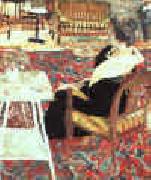 |
Edouard Vuillard
|
|
1868-1940
French
Edouard Vuillard Galleries
Jean-Edouard Vuillard, the son of a retired captain, spent his youth at Cuiseaux (Saone-et-Loire); in 1878 his family moved to Paris in modest circumstances. After his father\'s death, in 1884, Vuillard received a scholarship to continue his education. In the Lycee Condorcet Vuillard met Ker Xavier Roussel (also a future painter and Vuillard\'s future brother in law), Maurice Denis, musician Pierre Hermant, writer Pierre Veber and Lugne-Poe. On Roussel\'s advice he refused a military career and entered the Ecole des Beaux-Arts, where he met Pierre Bonnard.
In 1885, Vuillard left the Lycee Condorcet and joined his closest friend Roussel at the studio of painter Diogene Maillart. There, Roussel and Vuillard received the rudiments of artistic training. |
|
|
|
|
|
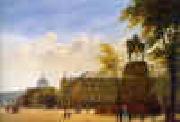 |
Eduard Gaertner
|
|
1801-1877
German
Eduard Gaertner Gallery
German painter and lithographer. His father was a master carpenter and his mother a gold embroiderer, and he had his first drawing lessons in 1811 in Kassel, where he had gone with his mother after the occupation of Berlin. After returning to Berlin he became in 1814 an apprentice painter at the Kenigliche Porzellanmanufaktur; and from 1821 he studied under Carl Wilhelm Gropius (1793-1870), then engaged as a painter of stage sets at the Kenigliches Theater in Berlin and also known for his townscapes. Here Gaertner developed skill in the rendering of perspective. He first exhibited at the Akademie der Kenste, Berlin, in the following year. In 1824-5 he was commissioned to paint interior views of Berlin Cathedral (see fig.) and the chapel of the Schloss Charlottenburg (both Berlin, Schloss Charlottenburg). In return, he was granted funds to enable him to spend three years in Paris, where he studied under Francois Bertin. Gaertner views of Paris already show his gift for lighting and use of staffage. His special ability lay in his understanding of the character of a city as the work of its inhabitants. After his return to Berlin he swiftly established himself as the leading painter of urban views, which he regularly showed at Berlin Akademie exhibitions. Interest in this genre grew along with the spate of building activity in Berlin after the end of the wars against Napoleon. There was a fresh interest in paintings of new buildings in particular, intended for a local rather than a visitors market. Two large views of the former Berlin Schloss, The Schleterhof and The Eosanderhof (both 1831; Potsdam, Neues Pal.), show Gaertner bold use of light and shadow. With the six-part panorama View over Berlin from the Roof of the Friedrich-Wedersche Church (1834; Berlin, Schloss Charlottenburg) Gaertner showed the spread of the city by this time. After painting a replica of this work for the Prussian king daughter Alexandra Feodorovna, Empress of Russia, in 1835-6 (St Petersburg, Hermitage), Gaertner visited Russia in 1837, and again from 1838 to 1839, staying in both St Petersburg and Moscow. He completed a large number of city views, including a three-part view of The Kremlin (1839; Berlin, Schloss Charlottenburg), commissioned by Frederick William III. With the death of the Prussian king in 1840, Gaertner lost his most powerful patron and interest in his work began to wane as it came to seem too stiff and objective to Romantic sensibilities. Gaertner tried to adapt to the change in taste, adopting a more painterly approach; in particular, he paid attention to effects of lighting. The vogue for city views had passed its peak, however, and Gaertner turned to landscape painting. Journeys to Prague in 1841-2, through West and East Prussia in 1845-6, and to Silesia in 1848-51 introduced new subjects; but it was architecture rather than setting that most engaged Gaertner attention. At this period he occasionally also invented ideal landscape settings for real buildings, as in the Ruined Monastery of Lehnin in an Imaginary Mountain Landscape (Berlin, Schloss Charlottenburg). Gaertner also produced watercolours of interiors and lithographs of both landscape and city views; but after the middle of the century his productivity in all respects dwindled. (An example of his work from this period is his oil painting of the Bauakademie and Friedrich-Wedersche-Kirche in Berlin (1868; Berlin, Tiergarten, N.G.; see SCHINKEL, KARL FRIEDRICH, fig. 2).) The rise of photography appeared to be making the architectural painter redundant. |
|
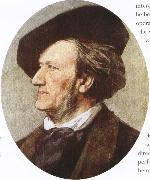 |
eduard hanslick
|
|
German music critic, aesthetician and pioneer of musical appreciation. He studied music with Tom??šek and read law at Prague University, writing his earliest essays for the Prague journal Ost und West and for the Wiener Musikzeitung, the Sonntagsblätter and the Wiener Zeitung. From 1849 to 1861 he was a civil servant, chiefly for the ministry of culture, meanwhile writing for the Presse, publishing his important book Vom Musikalisch-Schönen (1854) and lecturing on music appreciation at Vienna University, becoming full professor in 1870. He was also active as a musical emissary and helped promote the standardization of musical pitch. Among his long-standing friends were Brahms and the philosopher Robert Zimmermann. Though his aesthetic enshrined the classical ideals of orderliness and formal perfection, his interests were limited to the music of his own time. |
|
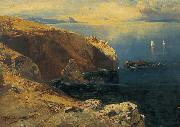 |
Eduard Hildebrandt
|
|
(1818 - October 25, 1868) was a German painter.
He served as apprentice to his father, a house-painter at Danzig. He was not twenty when he came to Berlin, where he was taken in hand by Wilhelm Krause, a painter of sea pieces. Several early pieces exhibited after his deathea breakwater, dated 1838, ships in a breeze off Swinemunde (1840), and other canvases of this and the following yeareshow Hildebrandt to have been a careful student of nature, with inborn talents kept down by the conventionalisms of the formal school to which Krause belonged.
Accident made him acquainted with masterpieces of French art displayed at the Berlin Academy, and these awakened his curiosity and envy. He went to Paris, where, about 1842, he entered the atelier of Isabey and became the companion of Lepoittevin. In a short time he sent home pictures which might have been taken for copies from these artists. Gradually he mastered the mysteries of touch and the secrets of effect in which the French at this period excelled.
He also acquired the necessary skill in painting figures, and returned to Germany, skilled in the rendering of many kinds of landscape forms. His pictures of French street life, done about 1843, while impressed with the stamp of the Paris school, reveal a spirit eager for novelty, quick at grasping, equally quick at rendering, momentary changes of tone and atmosphere.
After 1843 Hildebrandt, under the influence of Humboldt, extended his travels, and in 1864-1865 he went round the world. Whilst his experience became enlarged his powers of concentration broke down. He lost the taste for detail in seeking for scenic breadth, and a fatal facility of hand diminished the value of his works for all those who look for composition and harmony of hue as necessary concomitants of tone and touch.
In oil he gradually produced less, in water colours more, than at first, and his fame must rest on the sketches which he made in the latter form, many of them represented by chromolithography. Fantasies in red, yellow and opal, sunset, sunrise and moonshine, distances of hundreds of miles like those of the Andes and the Himalaya, narrow streets in the bazaars of Cairo or Suez, panoramas as seen from mast-heads, wide cities like Bombay or Pekin, narrow strips of desert with measure-less expanses of skyall alike display his quality of bravura. Hildebrandt died at Berlin on the 25th of October 1868.
|
|
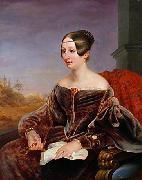 |
Eduard Magnus
|
|
(January 7, 1799 - August 8, 1872) was a German painter.
Magnus was born in Berlin, and studied simultaneously at the Berlin Academy of Art, Bauakademie, and University of Berlin. He later traveled to Paris and Italy, returning to Germany in 1829. He went to Italy again in 1831, and traveled through Paris and England before returning again in 1835. In 1837 he became a member of the Academy of Art, and in 1844 a professor. From 1850 to 1853 he traveled to France and Spain. He died in 1872 in Berlin. He was for a time the preeminent portrait painter in Berlin.
Eduard Magnus was the elder brother of the physicist and chemist Heinrich Gustav Magnus.
|
|
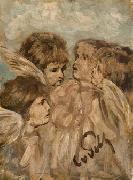 |
Eduard von Gebhardt
|
|
Franz Karl Eduard von Gebhardt (1838-1925) was a Baltic German historical painter. He was born in Järva-Jaani, Estonia, the son of a Protestant clergyman, and studied first at the Academy of St. Petersburg (1855-58). In 1860 he became the pupil of Wilhelm Sohn at Desseldorf, where he permanently settled, and became professor at the academy in 1873. One of his students was the German-Brasilian painter Wilhelm Techmeier.
|
|
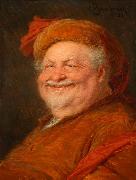 |
Eduard von Grutzner
|
|
(May 26, 1846 - April 2, 1925) was a German painter and professor of art especially noted for his genre paintings of monks.
Gretzner was born in 1846, the youngest of children, into a farming family in Groß-Karlowitz near Neisse, Upper Silesia in what is now Poland. The local pastor often visited his parents' home, as his father was a prominent member of the church. He recognized early on Eduard's talent and inclination for painting. Even as a child he drew on everything that fell into his hands. The administrator of a ducal country house in the neighborhood got him paper, and eventually the pastor gained him entrance to the Gymnasium (a university preparatory school) of Neisse, and brought him in 1864 with the help of an architect Hirschberg for art education at the private school of Herman Dyck in Munich. |
|
|
|
|
|
|
|
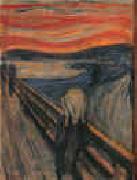 |
Edvard Munch
|
|
Norwegian
1863-1944
Edvard Munch Locations
Edvard Munch (pronounced , December 12, 1863 ?C January 23, 1944) was a Norwegian Symbolist painter, printmaker, and an important forerunner of expressionistic art. His best-known composition, The Scream is one of the pieces in a series titled The Frieze of Life, in which Munch explored the themes of life, love, fear, death, and melancholy.
Edvard Munch was born in a rustic farmhouse in the village of Adalsbruk in Loten, Norway to Christian Munch, the son of a prominent priest. Christian was a doctor and medical officer, who married Laura Cathrine Bjølstad, a woman half his age, in 1861. Edvard had an older sister, Johanne Sophie (born 1862), and three younger siblings: Peter Andreas (born 1865), Laura Cathrine (born 1867), and Inger Marie (born 1868). Both Sophie and Edvard appear to have gotten their art talent from their mother. Edvard Munch was related to painter Jacob Munch (1776?C1839) and historian Peter Andreas Munch (1810?C1863).
The family moved to Kristiania (now Oslo) in 1864 when Christian Munch was appointed medical officer at Akershus Fortress. Edvard??s mother died of tuberculosis in 1868, as did Munch's favorite sister Johanne Sophie in 1877. After their mother's death, the Munch siblings were raised by their father and by their aunt Karen. Often ill for much of the winters and kept out of school, Edvard would draw to keep himself occupied. He also received tutoring from his school mates and his aunt. Christian Munch also instructed his son in history and literature, and entertained the children with vivid ghost stories and tales of Edgar Allan Poe.
Christian??s positive behavior toward his children, however, was overshadowed by his morbid pietism. Munch wrote, ??My father was temperamentally nervous and obsessively religious??to the point of psychoneurosis. From him I inherited the seeds of madness. The angles of fear, sorrow, and death stood by my side since the day I was born.?? Christian reprimanded his children by telling them that their mother was looking down from heaven and grieving over their misbehavior. The oppressive religious milieu, plus Edvard??s poor health and the vivid ghost stories, helped inspire macabre visions and nightmares in Edvard, who felt death constantly advancing on him. One of Munch's younger sisters was diagnosed with mental illness at an early age. Of the five siblings only Andreas married, but he died a few months after the wedding. Munch would later write, "I inherited two of mankind's most frightful enemies??the heritage of consumption and insanity."
Christian Munch??s military pay was very low, and his attempts at developing a private side practice failed, keeping his family in perrenial poverty. They moved frequently from one sordid flat to another. Munch??s early drawings and watercolors depicted these interiors, and the individual objects such as medicine bottles and drawing implements, plus some landscapes. By his teens, art dominated Munch??s interests. At thirteen, Munch has his first exposure to other artists at the newly formed Art Association, were he admired the work of the Norwegian landscape school, and where he returned to copy the paintings, and soon he began to paint in oils. |
|
 |
Edvard Petersen
|
|
(4 February 1841 - 5 December 1911) was a Danish painter. He also designed the Stork Fountain on Amagertorv in Copenhagen
From 1851 he attended the Royal Danish Academy of Fine Arts. In the 1860s and 1870s he painted romantic landscape paintings under influence of Vilhelm Kyhn. He was a close friend of fellow painter Theodor Philipsen and together they went on several travels, including two stays in Italy between 1875 and 1880 and a visit to France.The friendship did not seem to influence Petersen's rather conservative style of painting and his works from the times abroad are generally traditional paintings of local life.
In the 1880s Petersen painted a number of figure paintings of street life in Copenhagen under influence of French Realism. His most famous paintings are Emigrants on Larsens Plads (1880) and A Return, the America Liner at Larsens Plads (894).
With his Stork Fountain proposal, Petersen won the competition for the design of a new fountain on Amagertorv in Copenhagen in 1888. The sculptor Vilhelm Bissen moulded the birds and the fountain was inaugurated in 1904
|
|
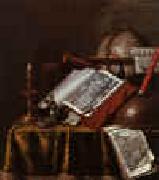 |
Edwaert Collier
|
|
Dutch
1640-1706
Evert Collier was born about 1640 in Breda, Noord-Brabant, and died in 1708. He is believed to have trained in Haarlem, as his earliest paintings show the influence of Pieter Claesz and Vincent Laurensz van der Vinne. By 1667, he had moved to Leiden, where he became a member of the Guild of St. Luke in 1673. He moved to Amsterdam by 1686 and to London in 1693. He was buried September 8, 1708 at St. James, Piccadilly.
The Denver Art Museum, the Honolulu Academy of Arts, the National Portrait Gallery (United Kingdom), the Rijksmuseum (Amsterdam) and the Tate (London) are among the public collections having paintings by Evert Collier. |
|
 |
Edward Armitage
|
|
(May 20, 1817 - May 24, 1896) was an English Victorian era painter whose work focussed on historical, classical and biblical subjects.
Armitage was born in London to a family of wealthy Yorkshire industrialists, the eldest of seven sons of James Armitage (1793 - 1872) and Anne Elizabeth Armitage nee Rhodes (1788 - 1833), of Farnley Hall, just south of Leeds, Yorkshire. His great-grandfather James (1730 - 1803) bought Farnley Hall from Sir Thomas Danby in 1799 and in 1844 four Armitage brothers, including his father James, founded the Farnley Ironworks, utilising the coal, iron and fireclay on their estate. His brother Thomas Rhodes Armitage (1824 - 1890) founded the Royal National Institute of the Blind.
Armitage was the uncle of Robert Armitage (MP), the great-uncle of Robert Selby Armitage, and first cousin twice removed of Edward Leathley Armitage.
|
|
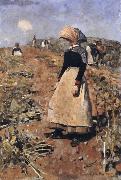 |
Edward Arthur Walton
|
|
British Painter, 1860-1922
He trained at the Staatliche Kunstakademie in Desseldorf (1876-7) and Glasgow School of Art. One of the GLASGOW BOYS, he painted outdoors in the Trossachs and at Crowland, Lincs, with James Guthrie, Joseph Crawhall and George Henry. He also painted in W. Y. Macgregor's life studio in Glasgow. He joined the New English Art Club in 1887 and developed an atmospheric landscape style influenced by plein-air painting and by James McNeill Whistler with whom he was friendly during his stay in London (1894-1904); Autumn Sunshine (1884; U. Glasgow, Hunterian A.G.) is characteristic. Walton was a regular exhibitor from 1880 in both Glasgow, at the Institute of the Fine Arts, and Edinburgh, at the Royal Scottish Academy. He was elected an Associate of the Academy in 1889 and a full member in 1905, taking an active role in its affairs after moving to Edinburgh in 1904. He concentrated after c. 1885 on pastel and on watercolour, which he used notably in his Helensburgh and Kensington scenes of contemporary life. From 1915 he served as President of the Royal Scottish Water Colour Society. Oil was reserved largely for portraits in a Whistlerian style, such as the Artist's Mother. |
|
|
|
|
|
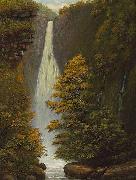 |
Edward Bailey
|
|
(1814-1903) was the most accomplished of the missionary artists in Hawaii. Along with his wife, Bailey arrived in Hawaii as a missionary-teacher in 1837 on the ship Mary Frazier. He worked at the Wailuku Female Seminary in Maui from 1840 until its closure in 1849. After the seminary closed, he built the still standing Ka'ahumanu Church in Wailuku and operated a small sugar plantation that eventually became part of the Wailulu Sugar Company. He began painting about 1865, at the age of 51, without any formal instruction.
Bailey's best known paintings are landscapes depicting the natural beauty of central Maui, The Bailey House Museum (Wailuku, Hawaii) and the Lyman House Memorial Museum (Hilo, Hawaii) are among the public collections holding works by Edward Bailey.
|
|
 |
Edward Beyer
|
|
painted The Peaks of Otter and the Town of Liberty in 1855 |
|
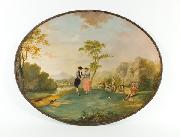 |
Edward Bird
|
|
(1877- 1968 ) - Watercolours
He was an English genre painter who spent most of his working life in Bristol, where the Bristol School of artists formed around him.. He enjoyed a few years of popularity in London, where he challenged the dominance of Sir David Wilkie in the genre painting field, before moving on to history painting, specialising in battle scenes.
|
|
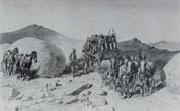 |
Edward Borein
|
|
American Golden Age Illustrator, 1882-1945,was an American artist and illustrator. He was the star pupil of the artist Howard Pyle, and became one of America's greatest illustratorsDuring his lifetime, Wyeth created over 3,000 paintings and illustrated 112 books, 25 of them for Scribner's, the work for which he is best known.Wyeth was a realist painter just as the camera and photography began to compete with his craft. Sometimes seen as melodramatic, his illustrations were designed to be understood quickly. Wyeth who was both a painter and an illustrator, understood the difference, and said in 1908, |
|
|
|
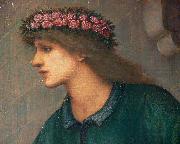 |
Edward Burne Jones
|
|
Sir Edward Coley Burne-Jones, 1st Baronet (28 August 1833 - 17 June 1898) was a British artist and designer closely associated with the later phase of the Pre-Raphaelite movement, who worked closely with William Morris on a wide range of decorative arts as a founding partner in Morris, Marshall, Faulkner, and Company. Burne-Jones was closely involved in the rejuvenation of the tradition of stained glass art in England; his stained glass works include the windows of St. Philip's Cathedral, Birmingham, Holy Trinity Church, Sloane Square, Chelsea, St Martin's Church in Brampton, St Michael's Church in Brighton, Cumbria, the church designed by Philip Webb, All Saints, Jesus Lane, Cambridge and in Christ Church, Oxford.
Burne-Jones's early paintings show the heavy inspiration of Dante Gabriel Rossetti, but by the 1860s Burne-Jones was discovering his own artistic "voice". In 1877, he was persuaded to show eight oil paintings at the Grosvenor Gallery (a new rival to the Royal Academy). These included The Beguiling of Merlin. The timing was right, and he was taken up as a herald and star of the new Aesthetic Movement.
In addition to painting and stained glass, Burne-Jones worked in a variety of crafts; including designing ceramic tiles, jewellery, tapestries, mosaics and book illustration, most famously designing woodcuts for the Kelmscott Press's Chaucer in 1896.
Edward Coley Burne Jones (the hyphen came later) was born in Birmingham, the son of a Welshman, Edward Richard Jones, a frame-maker at Bennetts Hill, where a blue plaque commemorates the painter's childhood. His mother Elizabeth Coley Jones died within six days of his birth, and he was raised by his grieving father and the family housekeeper, Ann Sampson, an obsessively affectionate but humorless and unintellectual local girl. He attended Birmingham's King Edward VI grammar school from 1844 and the Birmingham School of Art from 1848 to 1852, before studying theology at Exeter College, Oxford. At Oxford he became a friend of William Morris as a consequence of a mutual interest in poetry. The two Exeter undergraduates, together with a small group of Jones' friends from Birmingham known as the Birmingham Set, speedily formed a very close and intimate society, which they called "The Brotherhood". The members of the Brotherhood read John Ruskin and Tennyson, visited churches, and worshipped the Middle Ages. At this time Burne-Jones discovered Thomas Malory's Le Morte d'Arthur which was to be so influential in his life. At that time neither Burne-Jones nor Morris knew Rossetti personally, but both were much influenced by his works, and met him by recruiting him as a contributor to their Oxford and Cambridge Magazine which Morris founded in 1856 to promote their ideas.[ |
|
 |
Edward Burne-Jones
|
|
British Pre-Raphaelite Painter, 1833-1898
English painter and decorative artist. He was the leading figure in the second phase of the Pre-Raphaelite movement. His paintings of subjects from medieval legend and Classical mythology and his designs for stained glass, tapestry and many other media played an important part in the Aesthetic Movement and the history of international Symbolism. |
|
|
|
|
|
|
|
|
|
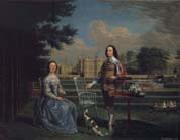 |
Edward Haytley
|
|
British Painter, active 1740-ca.1762,was an English portrait and landscape painter of the 18th century. Little is known about him, but the background of some of his sitters and professional contacts suggest he may have come from Lancashire. Few of his works survive, but he appears to have specialised in the "conversation piece" form popular with the landed gentry of mid-18th century England, a group portrait against an idealised backdrop of the subjects' estates. His works of this form include one of Elizabeth Robinson with her parents, Edward and Elizabeth Montagu, at Sandleford Priory near Hythe, Kent; six portraits of the Stanley family including one of Sir Robert and Lady Bradshaigh in front of Haigh Hall; and two of the Brockman family on its Kent estate, Beachborough, both showing the newly-constructed Temple Pond. One of the latter may include Susanna Highmore, daughter of the portrait painter Joseph Highmore. His best known works are the oil-on-canvas roundels of Bethlem and Chelsea Hospitals donated in 1740, at the behest of William Hogarth, to the Foundling Hospital, London. His last recorded work was a conversation piece of William Milner, second baronet, dated 1764, and he is assumed to have died shortly after this date |
|
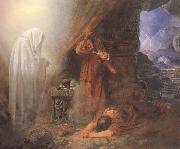 |
Edward Henry Corbould,RI,RWS
|
|
1815-1905
Painter, illustrator and sculptor, son of (2) Henry Corbould. A pupil of Henry Sass (1788-1844) and a student at the Royal Academy, he showed more wide-ranging interests than his father or uncle. He worked in watercolour and briefly in sculpture, winning gold medals for both from the Society of Arts (Fall of Phaeton, watercolour, 1834; St George and the Dragon, sculpture, exh. RA 1835; both untraced). He designed monumental figures for an unexecuted London County Council sculpture project for Blackfriars Bridge (1889), but he concentrated primarily on watercolours of literary and historical subjects, which he exhibited with the New Water-Colour Society from 1837 until 1898. |
|
|
|
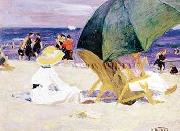 |
Edward Henry Potthast Prints
|
|
American Impressionist Painter, 1857-1927
Edward Henry Potthast (1857 ?C 1927) was an American Impressionist painter.
He was born in Cincinnati, Ohio. From June 10, 1879 to March 9, 1881 he studied with Thomas Satterwhite Noble. He later studied at the Royal Academy in Munich with the American-born instructor Carl Marr. After returning to Cincinnati in 1885 he resumed his studies with Noble. In 1886 he departed for Paris, where he studied with Fernand Cormon. In 1895 he relocated to New York City and remained there until his death in 1927. |
|
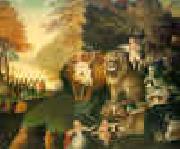 |
Edward Hicks
|
|
1780-1849
Edward Hicks (April 14, 1780 ?C August 23, 1849) was an American Folk painter, a distinguished minister of the Society of Friends, and he also became a Quaker icon because of his paintings.
Edward Hicks was born in his grandfather's mansion at Langhorne, in Bucks County, Pennsylvania. He was born into a life of luxury, and his parents were both Anglican. After his mother passed away when he was eighteen months old, Matron Elizabeth Twining - a close friend of his mother's- raised him as one of her own. She also taught him the Quaker beliefs. This had a great effect on the rest of his life.
At the age of thirteen he was an apprentice for coach makers William and Henry Tomlison. He stayed with them for seven years. His living situation inspired him to desire a much better way of life for himself. He wanted a simple, well respected life and to be able to earn his own wages. He wanted to be able to make choices for himself, in all that he did. It was then that he knew that something amusing and entertaining such as a career in art could satisfy his goals. He spent three years contemplating what his life meant to him, and grew a strong passion for art. His religious commitments affected his thoughts on living and art in many ways. In 1803, he married a Quaker woman named Sarah Worstall. |
|
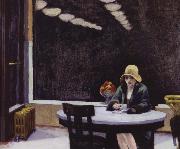 |
edward hopper
|
|
American painter, printmaker and illustrator. He was brought up in a town on the Hudson River, where he developed an enduring love of nautical life. When he graduated from Nyack Union High School in 1899, his parents, although supportive of his artistic aspirations, implored him to study commercial illustration rather than pursue an economically uncertain career in fine art. He studied with the Correspondence School of Illustrating in New York City (1899-1900). He continued to study illustration at the New York School of Art (1900-1906), under Arthur Keller (1866-1925) and Frank Vincent Du Mond (1865-1951), but began to study painting and drawing after a year. Hopper began in the portrait and still-life classes of William Merrit Chase, to whose teaching he later referred only infrequently and disparagingly. He preferred the classes he took with Kenneth Hayes Miller and especially those of Robert Henri. Hopper s skill won his fellow students respect, as well as honours in the school where, by 1905, he was teaching Saturday classes.
|
|
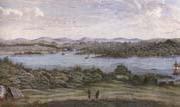 |
Edward John Eyre
|
|
1815-1901,British colonial administrator. In Australia (1833?C45) he was a magistrate, explorer, and writer on Australian geography, and had a reputation for sympathy for the aborigines. After terms as lieutenant governor of New Zealand (1846?C53) and governor of St. Vincent (1854?C60), he became (1864) governor of Jamaica. He was recalled in 1866 after suppressing a black uprising the year before in which more than four hundred Jamaicans were executed. Eyre was accused of brutality and illegal acts, especially in the execution of George Gordon, a black member of the Jamaican legislature who had contravened the martial law imposed during the emergency. He was recalled in 1866. Several attempts, promoted by John Stuart Mill, Goldwin Smith, and Herbert Spencer, to try him for murder were forestalled by a committee of admirers, which included John Ruskin, Alfred Tennyson, Thomas Carlyle, and Charles Kingsley. An English grand jury declined to indict him, and a royal commission exonerated him, while criticizing his ??unnecessary rigour.?? The episode contributed to the fall of the government of Lord John Russell in 1866. |
|
|
|
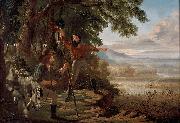 |
Edward Jukes Greig
|
|
b. 1839 Melbourne, Victoria
Also known as E. J. G.
Artist (Draughtsman), (Cartoonist / Illustrator), (Painter)
Colonial Victorian painter, cartoonist and illustrator.
Birth datec.1839Birth placeMelbourne, VictoriaDeath date4 October 1864Death placeSydney, New South Wales.
Residence 1864 11 Crown Street, Millers Point, Sydney, New South Wales
c.1860- c.1864 171 Victoria Parade, Melbourne, Victoria
Active Period 1860- 1864
|
|
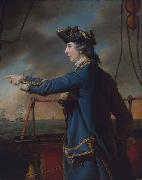 |
Edward Knowles
|
|
(born 1868 in Waberthwaite e died 29 June 1945 in Skiptone) was a rugby union footballer of the 1890s who at representative level played for England, and at club level for Millom,playing in the Forwards, e.g. Front row, Lock, or Back row. Prior to the 1899/1900 season, Millom was a rugby union club.
|
|
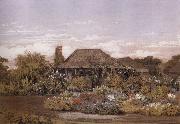 |
Edward La Trobe Bateman
|
|
book illuminator, draughtsman, architectural decorator and garden designer.
English
c.1815-1897
was a pre-raphaelite landscape artist, book illuminator and draughtsman. He was probably born in Derbyshire. Edward had lived in London where he had been engaged to the daughter of William and Mary Howitt. Edward visited Australia and stayed initially with Godfrey Howitt. In 1856, the Carlton Gardens in Melbourne were redesigned and Edward la Trobe Bateman was engaged to do the designs. |
|
 |
Edward lamson Henry
|
|
A popular and prolific genre artists at the end of the 19th century
American , 181-1919
American painter. He received his first art instruction in New York from Walter M. Oddie (1808-65), followed by two years at the Pennsylvania Academy of the Fine Arts, Philadelphia (1858-60). After this he left for a two-year stay abroad, studying with Paul Weber (1823-1916), Charles Gleyre and Courbet. In 1864 he served as a captain's clerk on a boat taking supplies to the Union army. Two notable pictures that emerged from this experience were City Point, Virginia, Headquarters of General Grant (1865-72; Andover, MA, Phillips Acad., Addison Gal. A.) and Westover Mansion (1869; Washington, DC, Corcoran Gal. A.). He soon won recognition and was elected to the National Academy by 1869. Many of his paintings were sold before exhibition, |
|
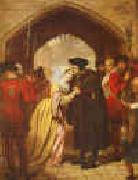 |
Edward Matthew Ward
|
|
British Painter.
1816-1879
His parents encouraged his early interest in art. He was sent to a number of art schools, including that of John Cawse (1779-1862), before gaining entry to the Royal Academy Schools in 1835. He first exhibited at the Royal Academy in 1834 with Adelphi Smith as Don Quixote (untraced). In 1836 he went abroad for further study, visiting Paris and Venice on the way to Rome, where he spent three years. His first work of any consequence was Cimabue and Giotto (untraced), which he sent back to the Royal Academy show of 1839. On the way back to England at the end of that year Ward visited Munich to learn the technique of modern fresco painting in order to take part in the competition to decorate the Palace of Westminster, but his cartoon, Boadicea (1843; untraced), was unsuccessful. However, in 1852 he was commissioned to produce eight pictures for the Palace of Westminster, on subjects drawn from the English Civil War, the best of which is the Last Sleep of Argyll (1860s) in the Commons Corridor of the Houses of Parliament
|
|
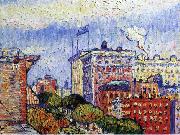 |
Edward Middleton Manigault
|
|
(June 14, 1887 - August 31, 1922) was an American Modernist painter.
Manigault was born in London, Ontario on June 14, 1887. His parents were Americans originally from South Carolina.Encouraged in art from an early age, he was commissioned at the age of 18 the city of London to make renderings of public buildings for reproduction as postcards. |
|
|
|
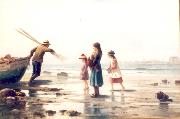 |
Edward Moran
|
|
(August 19, 1829 in Bolton, Lancashire, England -June 8, 1901 in New York City) was an American artist.
He emigrated with his family to America at the age of 15, and subsequently settled in Philadelphia, where after having followed his fathers trade of weaver, he became a pupil of James Hamilton and Paul Weber. In 1862 he became a pupil of the Royal Academy in London; he established a studio in New York in 1872, and for many years after 1877 lived in Paris. He was a painter of marine subjects and examples of his work such as Devile Crag; Island of Grand Manan are in many prominent collections. Among his canvases are 13 historical paintings, intended to illustrate the marine history of America from the time of Leif Ericsson to the return of Admiral Dewey's fleet from the Philippines in 1899.
His sons Edward Percy Moran (born 1862) and Leon Moran (born 1864), and his brothers Peter Moran (born 1842) and Thomas Moran. |
|
|

